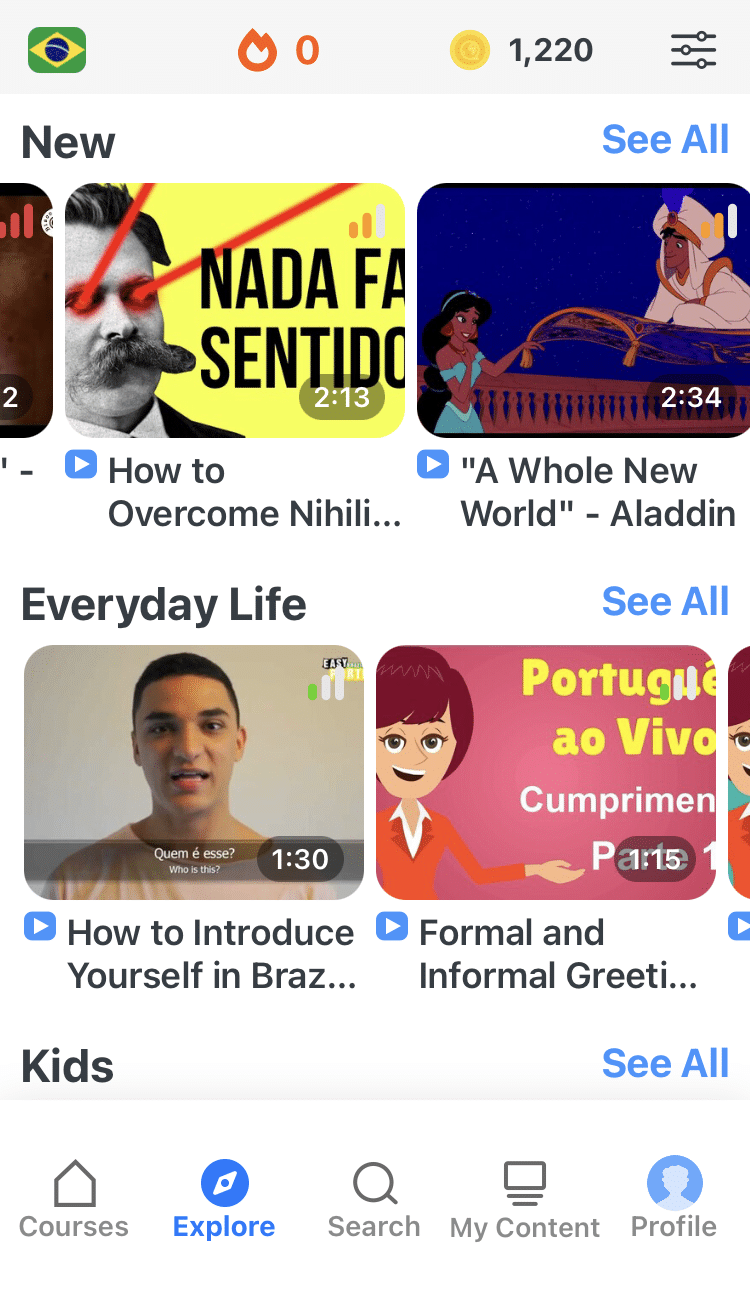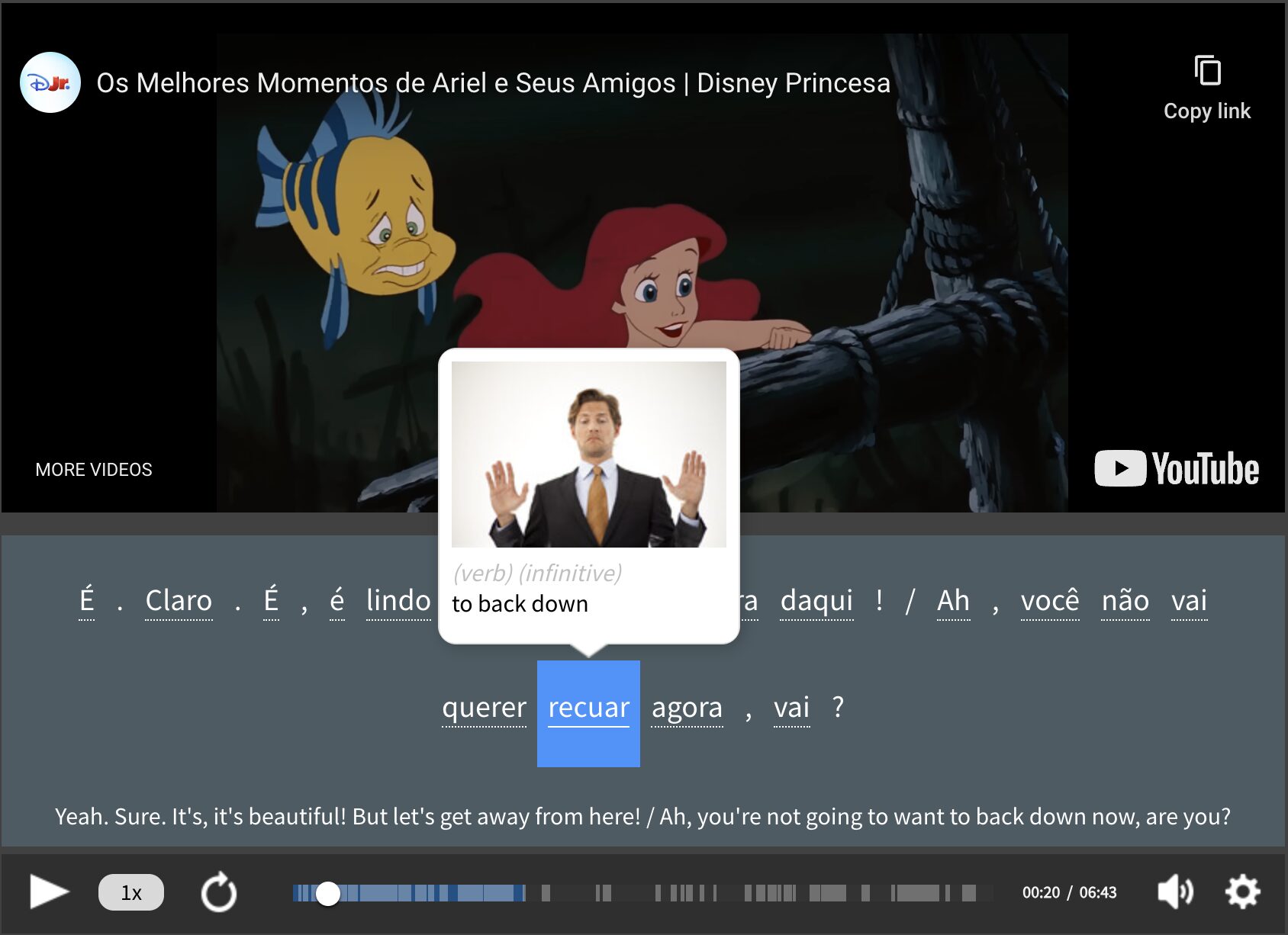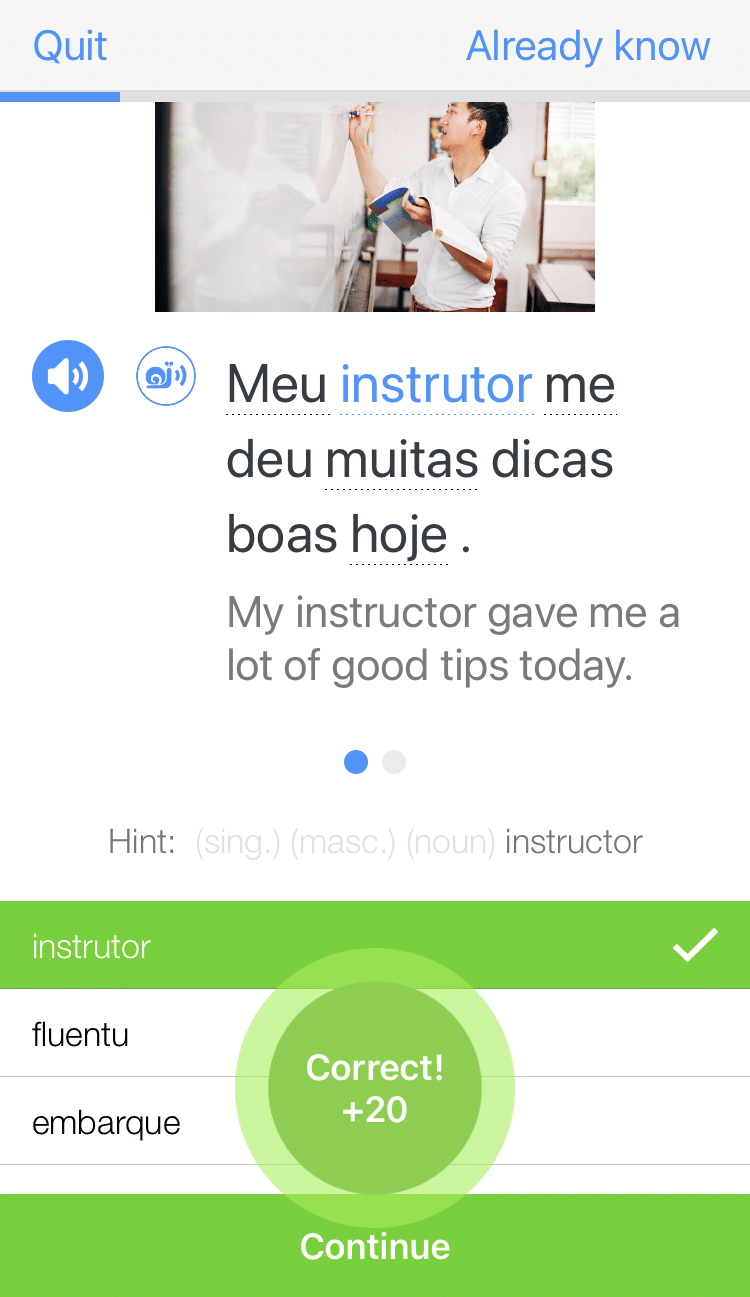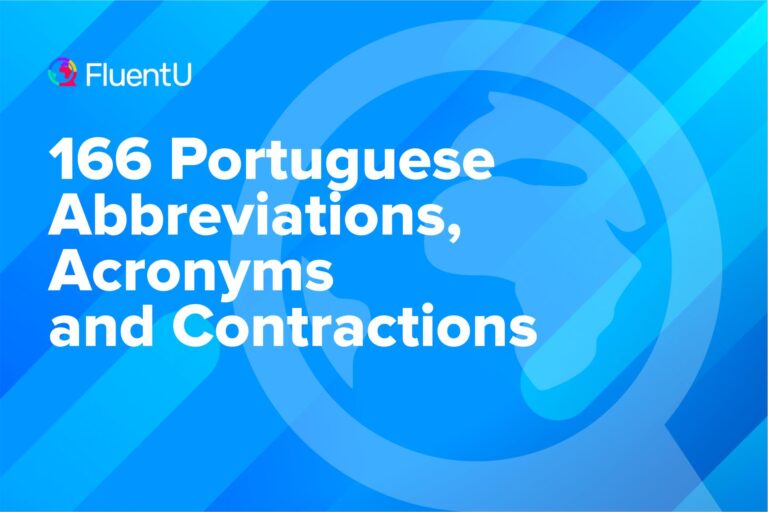Contents
- 1. “Cidade de Deus” (City of God)
- 2. “Central do Brasil” (Central Station)
- 3. “Tabu”
- 4. “Mistérios de Lisboa” (Mysteries of Lisbon)
- 5. “O Lobo Atrás da Porta” (A Wolf at the Door)
- 6. “Fados”
- 7. “Moro no Brasil” (The Sounds of Brazil)
- 8. “Branca de Neve e os Sete Anões” (Snow White and the Seven Dwarfs)
- 9. “A Menina da Rádio” (The Radio Girl)
- 10. “Carnaval Atlântida”
- 11. “Harry Potter e a Pedra Filosofal” (Harry Potter and the Sorcerer’s Stone)
- 12. “Os Simpsons: O Filme” (The Simpsons Movie)
- 13. “Monstros S.A.” [Brazil]; “Monstros e Companhia” [Portugal] (Monsters, Inc.)
- How to Learn Portuguese with Movies
- Building a Study Routine with Portuguese Movies
- And One More Thing...
13 Fantastic Movies to Learn Portuguese

It’s movie night and your popcorn is hot and fresh. You’re ready to sit back, relax and let the talented actors and directors of the awesome Portuguese language flick you just chose entertain you for the next 120 minutes.
Whether you’re a keen learner of Brazilian or European Portuguese, I’ve got plenty of handy tips and recommendations for learning Portuguese with movies. I’ve curated this list for you, which includes dubbed films and musicals all the way to must-watch classics.
Download: This blog post is available as a convenient and portable PDF that you can take anywhere. Click here to get a copy. (Download)
1. “Cidade de Deus” (City of God)
Where to watch: Amazon Prime | Google Play
This is one of the most popular Brazilian movies of all time.
The “City of God” favela (or slum) is one of the most dangerous areas in Rio de Janeiro, and the movie portrays the lives of two boys who grow up there, amidst poverty and violence. One of them even grows up to become a prominent druglord. The movie covers see three decades of relentless gang warfare, and it’s based on Paulo Lins’ semi-autobiographical novel.
2. “Central do Brasil” (Central Station)
Where to watch: Amazon Prime | Apple TV
“Central Station” is a Brazilian movie that won several awards and even became a worldwide hit!
It’s a deeply moving drama about a cynical, middle-aged woman whose life takes a dramatic turn when she crosses paths with a little boy. The boy’s mother dies, leaving him with no parents, so she’s forced to take him in. While she’s mistrustful of him at first, the two gradually become friends, and they even go on a quest throughout Brazil in search of the boy’s father.
3. “Tabu”
Where to watch: Amazon Prime
Considered a modern Portuguese classic, “Tabu” is set in two different time periods: in Lisbon during the present, and in Africa fifty years back.
A woman is already on her deathbed, but she has one last request: she wants her neighbor to find a specific man. It turns out that she had a passionate affair with this man before, when she lived on a colonial plantation in Africa—despite being married and pregnant.
4. “Mistérios de Lisboa” (Mysteries of Lisbon)
Where to watch: Amazon Prime | Google Play
This costume drama initially focuses on an orphan trying to uncover his mysterious past, then branches out to include various inter-connected plot lines, narrations and stories.
The award-winning film is based on a novel of the same name by Camilo Castelo Branco and is a notable 272 minutes long. In some countries, the movie was screened as mini-series because of its length.
5. “O Lobo Atrás da Porta” (A Wolf at the Door)
Where to watch: Amazon Prime
This is a dramatic thriller that’s centered around the kidnapping of an innocent child. As the police individually interrogates each of the abducted girl’s parents, it’s revealed that the father has a lover—who’s subsequently brought in for questioning. As police inquiries continue, a web of lies, vengeance, love and deceit begins to unravel.
6. “Fados”
Led by the Spanish director Carlos Saura, “Fados” is a documentary that fuses cinema, song, dance and instrumental performances to tell the history behind the fado—Portugal’s most emblematic musical genre. The fado is a musical tradition that’s been around since the 1820s, and the movie uses Lisbon as a backdrop to capture the style’s origins and melancholic undertones.
7. “Moro no Brasil” (The Sounds of Brazil)
Where to watch: Amazon
Finnish director Mika Kaurismäki goes on a musical journey across Brazil, the country he considers his second home. The documentary, which received the English title “The Sounds of Brazil,” taps into the diversity and uniqueness of each region’s musical styles—from the renowned genres like samba and bossa nova to the hidden treasures that are mostly unknown to the masses.
8. “Branca de Neve e os Sete Anões” (Snow White and the Seven Dwarfs)
Where to watch: Disney Plus | Internet Archive
The 1937 Disney classic is a great choice because it ticks the “something familiar” box, has dubs in both Portuguese dialects and you can even find the soundtrack on iTunes. This is actually a major film in the history of cinema because it was the first full-length animated film—and it helped launched Walt Disney to fame!
9. “A Menina da Rádio” (The Radio Girl)
Where to watch: YouTube
This classic musical from Portugal, with a title that roughly translates as “The Radio Girl,” tells the story of two rival shopkeepers and their children who are madly in love. As one of the shopkeepers decides to pursue his dream of creating his own radio station, he relies on the musical talents of his daughter and son-in-law to fulfill his vision.
10. “Carnaval Atlântida”
Where to watch: YouTube
The film’s title is both an ode to the Brazilian Carnival, as well as a celebration of the historic studio that produced it—Atlântida Cinematográfica—which was the most successful film production company in Brazil from the 1940s to the 1960s.
It’s a satirical musical comedy that follows a producer as he tries to make a movie about Helen of Troy. Tensions arise as the cast decides they would rather do a comedic take on the story despite the fact the producer hired a historian to help him write the script.
11. “Harry Potter e a Pedra Filosofal” (Harry Potter and the Sorcerer’s Stone)
Where to watch: Amazon Prime | Brazilian | HBO
Harry Potter fans will be pleased to know that dubbed versions are available in both Brazilian and European Portuguese. For those who might not have seen it yet, “Harry Potter and the Sorcerer’s Stone” is the first installment of the film series.
It follows Harry Potter as he discovers that he’s a famous magical wizard and embarks on his first year at the Hogwarts School of Witchcraft and Wizardry. Watch the dubbed Brazilian Portuguese trailer here and the subtitled European Portuguese trailer here.
12. “Os Simpsons: O Filme” (The Simpsons Movie)
Where to watch: Apple TV | Disney Plus
It may not be a children’s show, per se, but “The Simpsons Movie” still received its own European Portuguese voice-over. The 2007 American comedy film, based on the iconic TV series, follows Homer Simpson and his family as they’re kicked out of their hometown of Springfield after Homer accidentally pollutes the water supply and the town becomes encased in a giant dome.
Here’s a promotional ad from a Portuguese TV channel that’ll give you an idea of what to expect. You can also watch the dubbed Brazilian Portuguese trailer here.
13. “Monstros S.A.” [Brazil]; “Monstros e Companhia” [Portugal] (Monsters, Inc.)
Where to watch: Google Play (Brazil) | Google Play (Portugal)
“Monsters, Inc.” is a computer-animated movie by Walt Disney and Pixar that centers around two monsters, Mike Wazowski and James P. “Sulley” Sullivan. The duo work at Monsters, Inc., which is a company that generates the city’s power by scaring little children.
Confusion arises when a little girl enters the factory (children are viewed as toxic among monsters). Now Sulley and Mike need to find a way to return her home before it’s too late.
Note the subtle difference in titles for this one. The word “Inc.” was translated in Brazil as “S.A.” (short for sociedade anônima), while Portugal opted for the traditional “companhia.” For what it’s worth, both of them mean the exact same thing (company). Watch the Brazilian Portuguese trailer here and the European Portuguese trailer here.
How to Learn Portuguese with Movies
Focus on Something Familiar
Start out by choosing a few of your favorite blockbuster movies and tracking down their dubbed versions.
Here’s a quick rundown on how to do it. Go into Google Brasil or Google Portugal and type the English-language movie into the search engine. The Portuguese alternative should come up automatically.
Now, grab the localized movie title and do a search for it with either the word “dublado” (for Brazilian Portuguese searches) or “dobrado” (for European Portuguese alternatives) accompanying it. That’s it—nice and easy!
A word of warning for European Portuguese learners, though: In Portugal, dubbed movies tend to be the exception rather than the rule. Usually dubbing is reserved for shows, movies and cartoons geared toward a younger audience. To help make things easier, here are a few hit flicks that are dubbed in both dialects:
Move on to Subtitled Flicks
Let’s go for something local now. The first time you watch a new movie, focus on getting to know the plot and context of the film.
Then, over the next few playbacks, try to take in as much as you can without reading the text on the screen. The idea is to gradually wean yourself off the subtitles so you’re relying on your own comprehension.
If you’re stuck for movie ideas, you’ll find that Netflix has quite a few gems, as do many other online platforms like YouTube and Amazon.
Remember That Engagement Is Key!
Learning Portuguese with movies requires active, continual participation.
Pausing a film mid-scene to look up a word in the dictionary will distract you from the wider picture. Passively listening will add nothing to your linguistic skills, and trying to multitask while you’re watching the movie will likely make you miss out on important pieces of information.
What we’re trying to say is that you need to fully engage with the content. Keep a notebook handy so that you can quickly jot down any words you’re unfamiliar with. Listen actively, always trying to keep up with what’s going on. If you hear a word that you recognize—repeat it! That alone will greatly assist with pronunciation.
Here’s a video from our YouTube channel to give you an idea of how you can actively learn with movies like “Avengers”:
Still scratching your head as to how one engages with a movie? Try a musical out for size! Listen carefully to the song lyrics, try to sing along after watching a couple of times and use them as memory aides as you see the plot unravel on screen.
Building a Study Routine with Portuguese Movies
Learning Portuguese with movies isn’t something a beginner can dive into head first. Rather, the experience should be something that you build up to.
So before you start adding new movies to your “must-watch” list, take the time to really close in on those fundamentals. If you want to practice your listening skills before diving headfirst into watching movies, you can use a program like FluentU, which uses authentic short clips with interactive captions to teach you and train your skills.
FluentU takes authentic videos—like music videos, movie trailers, news and inspiring talks—and turns them into personalized language learning lessons.
You can try FluentU for free for 2 weeks. Click here to check out the website or download the iOS app or Android app.
Once you start building up your confidence in listening and basic comprehension, navigating through movie-based studies will be a cinch.
As you watch and listen, you should be able to see various word patterns and sentences cropping up—which in turn will not only help you learn by association, it’ll also give you some context to add to those grammatical structures you’ve been so diligently revising.
One final note—it’s recommended that you watch your chosen film two to three times so that you’re able to get the gist of the general plot line and dialog exchanges.
So this is why we strongly encourage you to make a habit out of incorporating movies (a weekly movie night is the best way to approach this), helping you establish an immersive learning environment in the comfort of your living room.
And that’s a wrap! Now that you’ve finished watching some great flicks, make sure to practice those skills and keep browsing for the next blockbuster hit that’ll help you speak Portuguese like a pro!
Download: This blog post is available as a convenient and portable PDF that you can take anywhere. Click here to get a copy. (Download)
And One More Thing...
If you're like me and enjoy learning Portuguese through movies and other media, you should check out FluentU. With FluentU, you can turn any subtitled content on YouTube or Netflix into an engaging language lesson.
I also love that FluentU has a huge library of videos picked specifically for Portuguese learners. No more searching for good content—it's all in one place!

One of my favorite features is the interactive captions. You can tap on any word to see an image, definition, and examples, which makes it so much easier to understand and remember.
And if you're worried about forgetting new words, FluentU has you covered. You'll complete fun exercises to reinforce vocabulary and be reminded when it’s time to review, so you actually retain what you’ve learned.
You can use FluentU on your computer or tablet, or download the app from the App Store or Google Play. Click here to take advantage of our current sale! (Expires at the end of this month.)










